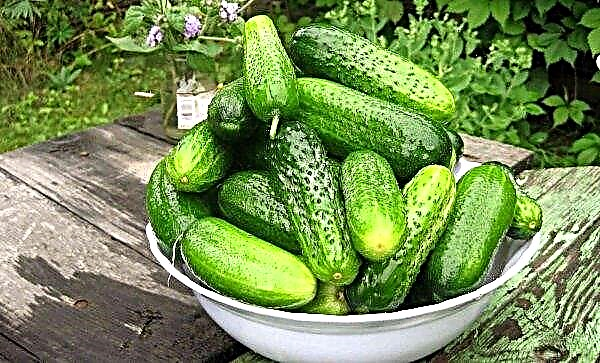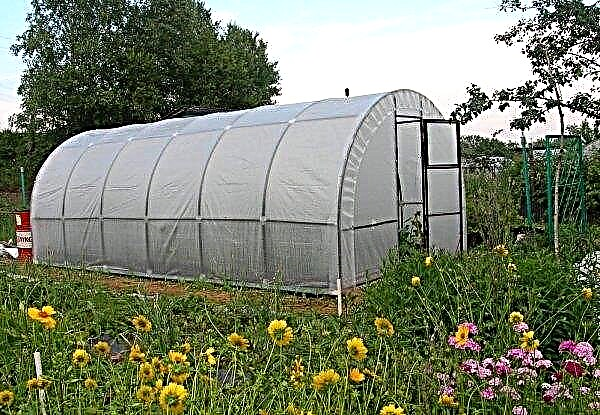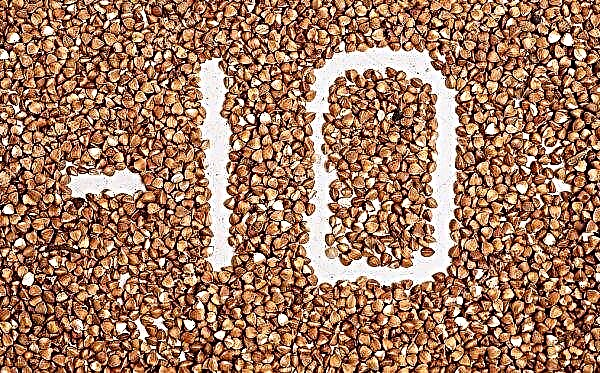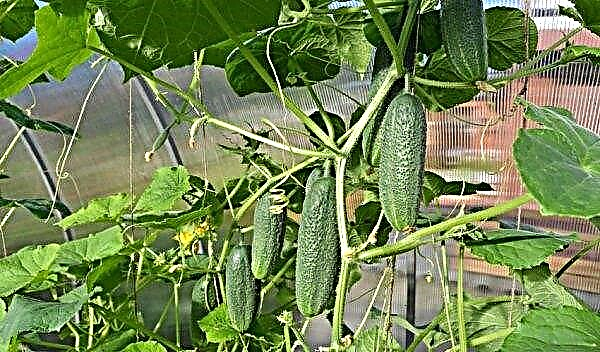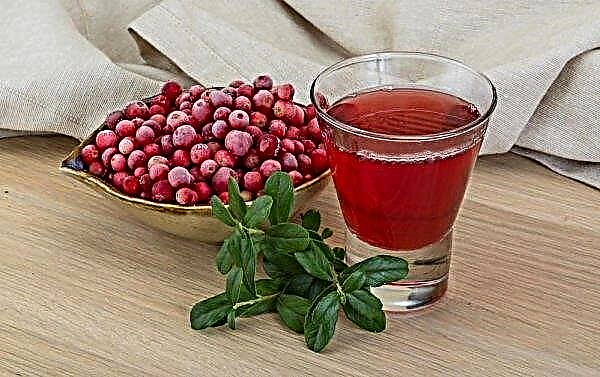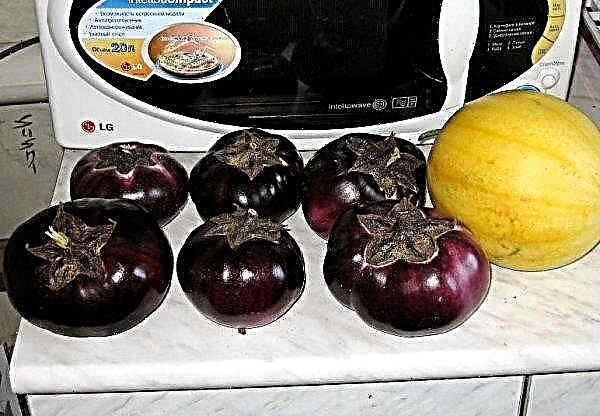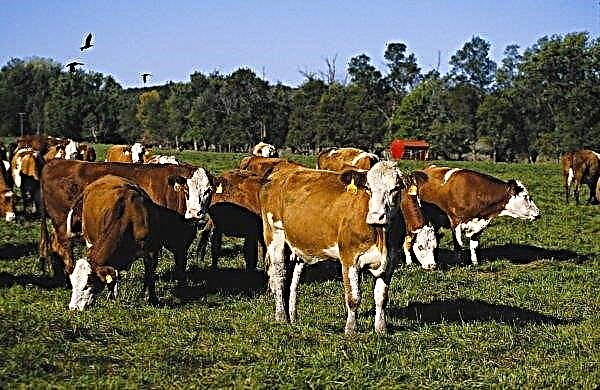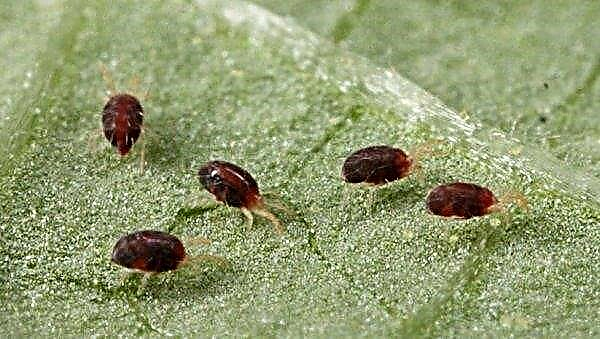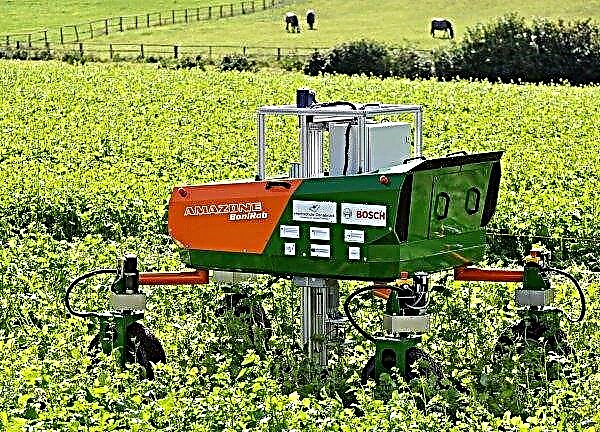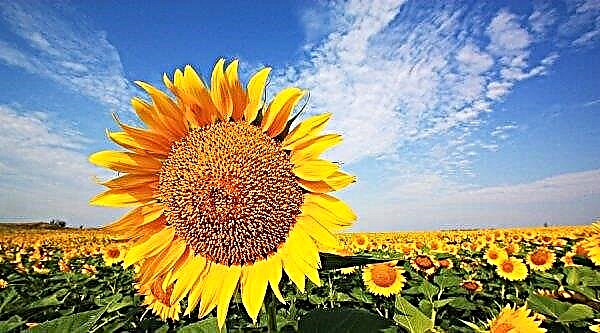Many gardeners, choosing a tomato variety for planting, are very wary of hybrid varieties. In fairness, it is worth noting that, indeed, many hybrids, despite all their advantages (good productivity, resistance to disease), can have a "plastic" taste. However, the hybrid tomato variety Velikosvetsky F1 is an exception to the rule - it will appeal to even the most demanding deli.
Grade description
Tomatoes of the Velikosvetsky F1 variety have a number of features that distinguish them from representatives of other varieties:
- this tomato belongs to the early ripening varieties, the first crop can be harvested 105 days after the appearance of the first seedlings;
- is a tall variety - the height of the bush can reach 2 m;
- has a slightly elongated cuboid shape of calibrated fruits;
- each brush contains from 5 to 9 fruits;
- the tomato has a dense skin and fleshy flesh;
- seeds in fruits a small amount.

Advantages and disadvantages
Like any other cultivar, Velikosvetsky F1 tomatoes have both strengths and weaknesses.
- The main advantages of this hybrid are:
- a successful combination of early ripening with high yields;
- resistance to various diseases and adverse conditions for development and growth;
- the same size of the fruit and a pleasant taste of pulp;
- fruit shape, which contributes to good transportability and keeping quality.
- The main disadvantages include:
- Mandatory garter due to the high growth of the bushes;
- the need for regular pinching due to the formation of many lateral shoots.
Self-growing seedlings
This tomato variety is perfect for growing in greenhouse conditions, and outdoors. The best option for growing tomato "Velikosvetsky F1" - seedling method. Adhering to the simple rules of planting and caring for this hybrid, you can easily get a large number of fruits of high quality and wonderful taste.
Did you know? In America, tomato is the most popular vegetable. It is grown in 93% of all US home gardens.
Optimum timing for sowing
To accurately determine the optimal timing, you need to know that usually sowing is carried out 2–2.5 months before transplanting seedlings on open ground or in a greenhouse.

First of all, it is necessary to focus on the air temperature (the temperature at +20 ° C is considered optimal for seedlings), as well as a sufficient amount of sunlight. It is good if the difference between daytime and evening temperatures is 5–7 degrees — this will harden the seedling, which will make it more resistant to adverse environmental conditions in the future. Given these features, sowing is carried out in March-April, in some cases - in early May. The first seedlings usually appear 5-6 days after sowing.
Important! Many gardeners and gardeners, when planting, often rely on the lunar calendar, however, the facts of the influence of the moon on crops are not scientifically confirmed and are often disproved.
The soil
In order for the seedlings to sprout faster and be healthy, it is necessary to prepare good soil for them. It can be either purchased or made with your own hands. Usually a soil mixture is prepared, which consists of turf land (1 part), peat (1 part), humus (1 part), sawdust (1 part) and ash (1.5 cups per 1 bucket of the finished mixture).
Capacity for growing
Before sowing seeds, it is recommended to prepare special containers for seedlings. You can use boxes or cassettes, as well as disposable plastic or peat cups. The latter will be needed when the seedlings enter the phase of 2 leaves - for their planting.

Seed preparation
Preparing seeds for sowing is the foundation of a solid crop, which is why experienced summer residents begin pre-sowing procedures in late February and early March.
There are a number of preparatory measures that need to be carried out with seeds before sowing:
- Sort and reject - It is known that from heavier and larger seeds grow more healthy and prolific plants. To select such specimens, the seeds are immersed in a previously prepared saline solution (1 teaspoon of salt is dissolved in a glass of water and insisted for about 10 minutes). Full-bodied seeds sink to the bottom of the glass, and small and dry seeds float to the surface (they need to be removed).
- Disinfection - It has long been known that many plant diseases can function on the surface of seeds. To avoid this, all seeds undergo a disinfection procedure before planting - they are kept for about 20 minutes in a 1% solution of potassium permanganate or 7-8 minutes in a 3% solution of hydrogen peroxide heated to +40 ° С.
- Nutrient Impregnation - to improve the quality of yield, the seeds are soaked in special solutions before sowing for 24 hours. You can use folk recipes - aloe or potato juice or industrial preparations. After soaking, the seeds are dried without rinsing.
- Germination - to accelerate the growth of seedlings and earlier ripening of the crop, tomato seeds are left in the saucer covered with wet gauze or wet filtered paper before sowing.
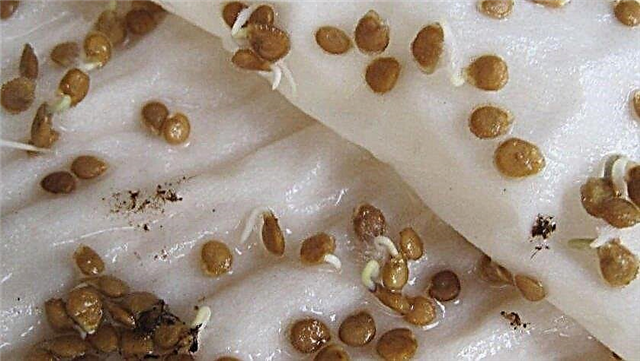
- Hardening - to increase the resistance of tomato bushes to adverse weather conditions, as well as to increase the quality and quantity of the crop, tomato seeds before planting 2-3 times are placed overnight in a refrigerator (at a temperature of 0 ... -2 ° C) for 12 hours.
Did you know? For a long time, tomatoes were considered poisonous plants. Gardeners used them as exotic ornamental plants.
Sowing seeds
Before planting seeds, the prepared container is filled with soil 3 cm below the edge. After that, the soil mixture is watered and, covered with a film, left for a day - this will allow moisture to evenly penetrate the soil. Immediately before sowing the seeds, the ground in the container is leveled and holes are made with a depth of not more than 1.5 cm, where the seeds are planted. From above, the container must be covered with polyethylene, which artificially creates high humidity. To accelerate the appearance of sprouts, the ambient temperature should be at least +25 ° C. After the first shoots, the film is removed to prevent rot.
Seedling Care
The first sprouts usually appear around 7-8 days after sowing the seeds. During this period, it is very important to have enough light and to observe the temperature regime - after the appearance of the first sprouts, the temperature must be lowered to +15 ° C for 5-6 days. After that, allowing the sprouts to grow stronger, the temperature in the daytime rises to +24 ° C, and at night - to +12 ° C. After the appearance of the first leaves, seedlings should be dived - for the root system to grow, the main root is pinched during a dive.

Seedlings of this variety of tomatoes need to be fed. The first time fertilizers are administered on the 10th day after planting, the second time - two weeks after the first. As a top dressing, you can use ready-made purchased fertilizers or cook them yourself. For this, 4 g of urea, 30 g of superphosphate and 10 g of potassium sulfate are diluted in 10 l of water and the soil is watered with this solution.
The main care after top dressing consists in watering and loosening the soil. It is worth paying attention to two such important factors for the healthy growth and development of plants, such as light and water. In order to avoid diseases and even death of seedlings, watering should not be excessive, and light should be abundant.
Seedling hardening
Hardening seedlings is a very important procedure, which allows future tomato bushes to easily tolerate adverse weather conditions. The hardening procedure usually begins 2 weeks before transplanting seedlings in open ground. To do this, after waiting for warm spring days, when the air temperature warmed up to at least +12 ° C, seedlings are taken out to the street. Such procedures should begin with half an hour and gradually increase the amount of time spent by seedlings in the air.

When hardening, avoid direct sunlight and plants to monitor the absence of drafts. Hardened seedlings in the future can easily tolerate the first autumn frosts, when the air temperature can drop to -5 ° C.
Planting seedlings in a permanent place
Planting seedlings in a permanent place is carried out at the age of 60-65 days. Usually this time falls on the end of May-beginning of June. The area occupied by plants is determined depending on the bush. When growing tomatoes in two stems - per 1 square. m of planted area 3 plants, in one stalk - per 1 square. m planted on 1 plant.
Outdoor Care
Tomatoes, although they are unpretentious plants, are still very responsive to care - minimal care immediately affects the quantity and quality of the crop. There are a number of basic rules of agricultural activities, adhering to which, it is guaranteed to get a large number of juicy and sweet tomatoes.

Watering
When watering tomatoes, you should avoid both an excess of moisture and overdrying the soil. Usually, if there is no rain, watering is done once a week - tomatoes are rarely watered, but plentifully. Water is poured under the root of the plant, not falling on the upper leaves, as this can lead to the formation of vertex rot. It is imperative to ensure that from the time of the ovary to the end of the fruit filling, the water is in the right amount, otherwise you can either lose the crop or get atypically small fruits.
Do not forget about the constant loosening of the soil every time a crust forms on the ground.Important! Tomatoes will grow better and be less likely to hurt if ash is added to the bucket of water for irrigation (a few pinches per 10-liter bucket), or ashes sprinkle ash around the stem of the tomato.
Top dressing
Tomatoes are plants that require fertilizer for better growth and fruit development. The ideal option is a systematic feeding every 2-3 weeks, but you can do with a minimum quantity of 3 times for the whole season. As fertilizer, you can use either ready-made purchased mixtures, or self-cooking top dressing. The main thing is that they contain nitrogen in a minimum amount, and potassium and phosphorus predominate. You can also use organic fertilizers - bird droppings are good.

Stepson
The process of pinching is not mandatory and is carried out to form bushes and obtain more fruits. Most often, one main stalk is left in the tomato bush, the remaining stepsons that appear in the bosom of the stem are removed. In the days of strong summer heat, it is better to refuse pinching for a while, because plants in such conditions do not tolerate injuries. But during prolonged rains it is better to carry out stepsoning constantly, removing at the same time the lower foliage for the quickest warming up of the bush and its ventilation.
Video: All About Tapping Her Tomatoes
Soil care
To get a rich harvest, the soil on which the tomatoes grow needs constant care.
Among the main and effective methods of care are:
- weed weed - the mandatory procedure for removing the root system of weed grass from the soil in which tomatoes grow, this allows you to save all the nutrients and moisture in the soil for the development and growth of tomatoes;
- loosening - a procedure by which the soil under the tomatoes is enriched with oxygen and retains moisture well;
- mulching - covering the soil around the plants with any material (mowed grass, fallen leaves, straw, sawdust, etc.), this allows you to save heat (especially true for cold regions) and soil moisture.

Bush tying
Tieing bushes is especially important for this variety of tomatoes, the height of which can reach 2 m. Stakes for garter are driven into the ground at a distance of about 10 cm from the stem, to a depth of about 40 cm. The height of the stakes is selected according to the expected height of the bush. The first garter occurs immediately after rooting the seedlings and the beginning of its growth. Sometimes horizontally stretched wire is used instead of stakes, and, as practice shows, in this case the fruits of the harvest will be slightly larger, and it will be easier and more convenient to harvest.
Preventative treatment
Tomatoes are particularly vulnerable to diseases and all kinds of pests, so these plants need regular and systematic care. In the case of diseases, one must remember that prevention will always be better, safer and cheaper than treatment. You can start maintenance work already in June, when the air temperature is still not too high. At this time, you can get by with traditional methods of prevention, which are safer than chemicals.

To prevent disease, the following solutions are used with which you can spray tomato bushes:
- milk solution - 2 l of water is mixed with 2 l of milk and whey;
- garlic solution - 200 g of chopped garlic is poured into 3 liters of water and insisted for a day, then diluted with 10 liters of water with 20 g of laundry soap;
- weak potassium permanganate solution - 0.1 g of potassium permanganate is dissolved in 10 l of water.
Did you know? Tomatoes are known as “non-lethal weapons” in all kinds of protests in different countries of the world. They are usually bombarded by protesters of those against whom they are opposed.
Harvesting
The harvesting period mainly depends on how much time the fruits plan to store.
Based on this, the stage of tomato maturity is selected by its color:
- green - the earliest stage, which involves a long storage time;
- brown - the middle stage of storage;
- pink or red - The maximum shelf life is not more than 7 days.

In general, the Velikosvetsky F1 tomato variety is quite unpretentious in maintenance, and the requirements for caring for it are minimal. With a large number of advantages, this hybrid is often chosen as the main one in the gardens and greenhouses of both experienced gardeners and beginner gardeners.




